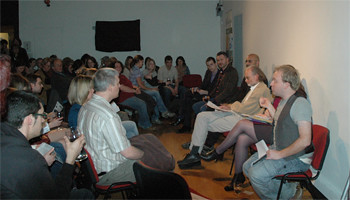The following is an essay by Dr. Alex Hillman and relates to the sciSCREEN following a discussion of Robot and Frank.
A major point of
interest for medical sociologists is the relationship between public
understandings of illness and disease and the wider cultural preoccupations of
our society. Memory problems and
cognitive impairment in later life represent two of contemporary western
societies’ biggest anxieties: old age and mental illness. Often representations of illnesses in popular
culture, politics and the media can tell us more about the society we live in
than the nature of the disease itself.
Accounts of Alzheimer’s disease and dementia, particularly from
politicians and in the national press, tend to evoke quite frightening
images. One particularly powerful and
prominent image of dementia is that it is a kind of living death for its
sufferers; the body remains but the person is lost. The language of loss and determinism also
shape descriptions of the growing incidents of Alzheimer’s disease and dementia
amongst populations, referring to the rising tide of dementia that is
suggestive of an unstoppable force that is out of our control. Smaller, personal stories that attempt to
shed light on the experience of dementia tend to focus on the extremes of the
disease, making dementia freakish, something that happens to ‘them’ rather than
‘us’. These stories also tend to take an
outside view, highlighting the oddities of those with dementia and witnessing
their condition as something alien.
The film Robot and Frank
does something quite different by enabling us to experience the world through
Frank’s eyes. Frank’s mistakes tend to
derive from him being out of time. For
example, for Frank, his son Hunter is still at Princeton
and not the grown up man with a family of his own that he is presented
with. But, we, the audience, are taken
into Frank’s world so that his failures or lapses in memory are only made
noticeable to us through the responses of the people around him and the
physical environment that forces him to rethink his own perception.
The problems experienced
by Frank are in a sense indicative of a fraying society in which the provision
of care to an increasingly aged population is problematic. The introduction of Robot into the film is a
response to the big question facing western societies: how do we provide care for vulnerable older
people? In societies that celebrate and
reward independence and autonomy, and where families are becoming increasingly
fragmented, how do we meet the needs of people like Frank? The film portrays Robot as a futuristic solution
to this societal problem. However we
need not look to the future to see the growing significance of technology as a
potential solution to the challenges of an ageing population. Growing numbers of telemedicine programmes and
the development of so called ‘smart homes’ that protect independent living are
just two current examples.
The relationship between
the robot and Frank and the extent to which the robot is and can provide care
is interesting. It is somewhat ambiguous
in the film as to whether Frank’s spiral into criminality is good or bad. What the film does show is how the practices
and activities that made up that criminal activity, such as picking a lock or
‘casing’ a building or reading and interpreting building plans, allow Frank to
find part of his identity. It is in
carrying out these physical tasks that Frank recalls aspects of his past life
and relationships and where we get the greatest sense of who he was and is.
There are some
existential questions raised through the relationship between Frank and the
robot about memory, identity and humanity: what is it that makes us human? It brought to mind a poem by Tony Harrison
about the nature of identity and its relationship to memory in which he writes:
“If we are what we remember, what are they who don’t have memories as we have
ours”. There are two key moments in the
film that speak to this very question.
The first moment is when Frank argues against that robot’s suggestion of
wiping its memory and at the end of the film when Frank eventually turns the
robot off. These two moments suggest an
interesting contrast between the robot and Frank. The robot represents societies’ fears about
dementia, that it’s a kind of living death, that if we lose our memory we cease
to be. There are deep rooted
philosophical assumptions that underpin this conception, that cognitive
impairment necessarily means losing our humanity. As a society we tend to separate and
privilege the mind over the body, recognising cognition as essential to
personhood. In a sense, for the robot,
which has been created to replicate this very idea of human cognition, this
fear is realised in the final act of the film.
Frank on the other hand,
even with his failings and the tragic consequences of his cognitive decline,
remains a person. What remains of himself may be less fitting to the
world and the people that surround him but Frank’s humanity endures.
This is because unlike the robot, Frank’s selfhood is made up of more than
cognition alone. He exists in the world differently to the robot.
There are aspects of Frank’s being that are pre-reflective, that reside below
the threshold of cognition that are acted out through the body, like the
picking of locks for example; that rely on emotional response, as we see
through his affinity with and affection for his ex wife (although not
remembering who she is); and finally that rely on the successful deployment of
social practices learned through processes of socialisation that provide people
with the know-how, skill and disposition to act appropriately in their social
worlds. The social nature of what make us uniquely human is made clear during
the party scene in the film when the robot is incapable of exchanging social
pleasantries.
What is interesting
about this contrast between Frank and the robot is that it highlights Frank’s
enduring humanity. This has significant
consequences for thinking about dementia care, as it suggests that attending to
and promoting aspects of selfhood are important and that these aspects of care
are themselves humanising. Robot and
Frank, in a very light touch way, raises profound questions about the relationship
between memory, identity and humanity and perhaps challenges the image of dementia
as a living death.
Reading:
‘The Mother of the
Muses’ a poem by Tony Harrison
Hannah Zeiling (2013)
‘Dementia as a cultural metaphor’ in The Gerontologist
Pia Kontos (2004)
Ethnographic reflections on selfhood, embodiment and Alzheimer’s disease in
Aging & Society, Vol. 24, pp. 829-849








This Wonderful film, provoked in me like you thoughts about what it means to be human, that is to say what endures with us through out life essentially what is "eternal". I think what this story points to is more than just the material sense of cognitive disorders and how to approach them humanely with one another. It points to human atonement and acceptance. This is the awakening if you will from the "dream of ambition" so aptly shown in Mad Men to the "embrace of self awareness" in the highest sense. Often we(especially men) are torn in our lives between ambition(doing) and acceptance(being). The cognitive dissonance between the two has allowed for separate lives to be lived by many of us in a state of dementia/amnesia that has nothing to do age per say. But has to do with the question of "to be or not to be". This story allows Frank to revisit(through the mediated extension - to riff on Mcluhan - of the robot)his former life, separate from his family life and to come to terms with his actions in the world and let them go to move towards eternity and reclamation and indeed a rebirth or re-awakening into family life(through his remembrance of his family life and his wife by coming to terms with himself and her in a picture on the "librarians" wall. This can be seen as the robot so takes on the mannerisms of a jewel thief that Frank is happy to "erase the past" and take his place in eternity. This is also seen as all the other men in the retirement community(elder care facility), are still embracing clutching their past in the form of the robot extensions of what they once were but Frank, Frank is truly free.
ReplyDeleteSurfpunk